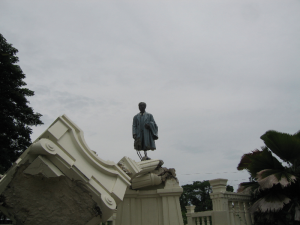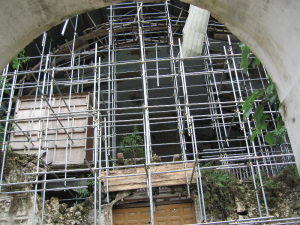Picking up the pieces in Bohol

Rizal statue sans legs in Loon’s plaza. PHOTOS BY LH FRANCIA
NEW YORK CITY — Before leaving Tacloban for Tagbilaran, I managed to visit the nearby coastal town of Dulag (population 48,000), facing Leyte Gulf. (Some residents have argued that it was there on Dulag’s beaches that MacArthur waded ashore, not at Palo, which is much closer to
Tacloban.) The town seems all but recovered, with City Hall, the Civic Center, and the public market rebuilt. It was easy to meet its mayor Manuel Sia Que who exudes bonhomie and has a can-do spirit. He candidly and cheerfully admitted to no particular party loyalty, enabling him to work with whoever was in power: “You don’t run against the course of the river.”
At the office of his construction business, he narrated how “a week before Yolanda, a tornado hit the town, toppled 70 houses along the shore. So when the news came out that Yolanda was coming, we went to the coastal barangays two days before and evacuated the residents. They followed orders, with one question: will you feed us tonight.” During the onslaught of biblical proportions, the mayor proudly points out, only two locals perished, an old man who refused to move, and a younger man felled by a coconut. Some 18 bodies floated ashore, but these victims were from other places. Economic damage was much more substantial: 75 percent of coconut trees were uprooted, and rice lands were flooded. The mayor had his men clear the roads with company equipment so that relief goods could come in, which they did three days after.
However, the relocation of approximately a thousand residents living along the shoreline had yet to happen and so they continued to live by the sea. The mayor said relocation plans were ready to be implemented, with funds raised partly from Europe, mainly through the efforts of Daniel Johannot, a Swiss national who happens to be married to a cousin of mine, Purissima Benitez. Land had been set aside, its owner willing to sell, about a mile away from the coast. To build the infrastructure for what will essentially be a new baranggay, government approval was needed, specifically that of the National Housing Authority. That it seemed to take an inordinate amount of time to secure approval was not surprising, but why exactly was anyone’s guess. In the meantime, everyone hoped that the town would be better prepared for the next supertyphoon.
In Bohol, my on-site visits were facilitated by the Manila-based Boholano, Fr. Ted Torralba, who is with the National Commission on Culture and the Arts (NCCA) and sits on its Committee for Monuments and Sites. He put me in touch with the Tagbilaran diocesan Chancellor, Fr. Agerio Paña who assigned the diocese’s driver Manong Boy Leopardas to bring me around. Brother Solomon V. Ostique, due to be ordained next year, was my knowledgeable guide.
I was happy to be here once again. It was as I remembered it, still relatively green, with mangroves in abundance, at least along the coastal routes we took. In contrast to nearby Negros Island, Bohol has had history of haciendas and is thus not plagued by the feudalistic, patron system that is part and parcel of hacienda culture. And water is abundant, unlike in Cebu.

The rubble of the Loon church.
The island has probably the most number of Spanish-era Catholic churches in the country. Fr. Torralba pointed out that Bohol “has the highest concentration of heritage sites in the country, of colonial-era churches. Now it can be the laboratory” for the restoration of such structures. Not all the damaged churches are considered heritage ones, and have been informally labeled “orphans.” One such is that of Antequera, having been erected during the American colonial period.
Fortunately, the damage here was not as severe as elsewhere. The designation is important, as the restoration of a heritage church is then funded through the national government, under the supervision of the NCCA and the National Museum. In contrast, local governments bear the responsibility of restoration or rebuilding.
We visited two edifices that the quake completely leveled: Maribojoc’s 17th-century Holy Cross Church and Loon’s 18th-century Our Lady of Lights Church. The two towns were near the epicenter of the October quake of 2013. At both sites crews were clearing away the rubble and setting aside blocks of stone and any other items, such as bells, which could be used in rebuilding. In the meantime to serve the faithful, temporary chapels had been set up—as was the case in the other sites—which will have to do while the painstaking process of rebuilding or reconstructing takes place. The Rizal statue in Loon’s plaza was without limbs, but with its familiar face and morning coat still stood on its steel bars. I wondered why the town hadn’t as yet restored the Rizal, surely not as complicated as rebuilding a church.
When all the work will be done depends on the extent of the quake damage. Some churches such as that in Cortes and Loboc suffered severe damage to their interiors, but the main structures remain intact. The best known and thus the most visited is the 16th-century Baclayon Church, on the outskirts of Tagbilaran. From the grounds, one gets a lovely view of the sea. Here, the freestanding bell tower suffered the most damage. That done to the church itself was relatively minor. Brother Solomon and I walked around the interior. We were able to do the same at some of the other sites, even though the interiors had been closed and deemed unsafe for anyone but workers to enter. Here in Baclayon the church was open for business. The museum in the konbento was open, and had a fair share of visitors.
The primary question is, does one restore and reconstruct or build a new church entirely? I posed this question in an e-mail to Roz Li, a New York-based architect who, until her retirement in 2012, was president of Li/Saltzman Architects, a firm that specializes in historic preservation and was involved in some of the post 9/11 restoration in downtown Manhattan. Currently, she heads Bakas Pilipinas, a New York-based not-for-profit organization dedicated to the preservation of historic architecture and sites in the Philippines. It’s worth quoting here most of her reply:
“According to internationally accepted protocols for preservation, to decide whether or not to reconstruct a totally damaged heritage building or to design a modern replacement is usually based on how much documentation of the former building is available. Reconstruction is justified if it is based on accurate documentation of what was there. If there is no accurate documentation available, then a new building, which reflects modern times, is preferable. We don’t want to confuse people by ‘recreating’ loosely. Then it will have no authenticity and it becomes ‘Disneyland.’ ‘Authenticity’ and ‘historical Integrity’ are important in the preservation field.

Scaffolding for the Loboc church.
“I have not seen any measured drawings of the churches damaged by the earthquake in Bohol, although there has been some talk that some of them have it. Photographs can also be a source of information, but photos are tricky because they do not have dimensions, and usually, they are not complete.
“This is one of the projects which we would like to happen in the Philippines—the historic survey and documentation of heritage buildings in a standardized manner, to be stored in a national depository or archives. Right now, it is spotty. I heard Vigan is well documented (I have not seen it), as well as some towns in Pampanga. But I don’t know the level of documentation. (For example, does it have enough accurate information as a basis for reconstruction?) In the U.S., we have the Historic American Building Survey (HABS, under the U.S. Department of the Interior). We need the equivalent agency in the Philippines.
“Years ago, I approached UNESCO to ask them to fund a national survey for Philippine heritage buildings but I was told they didn’t have the funds for that. The Philippine government should implement such a program. As it turns out, the Philippines is one of the few countries in the world, which does not have a national historic building survey. I was told even the poorest African countries have it.”
Recently Bakas submitted a grant proposal to the US Ambassador in Manila for a laser survey and documentation of three “orphan” churches in Bohol, in Antequera, Catigbian and Sikatuna, built during the American colonial period. Their restoration is not being funded by the NCCA, hence the term “orphans.” Roz and Bakas are hopeful the funding will come through.
In the course of my Bohol visit I once again came across the name of an early 20th-century artist known for the murals he painted on Bohol’s church ceilings: Raymundo Francia.
(To be continued)
Copyright L.H. Francia 2015
Like us on Facebook














